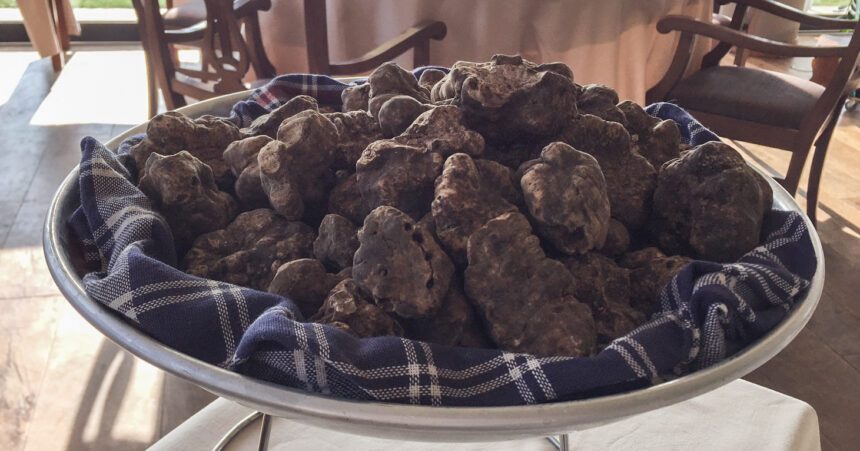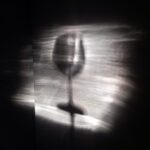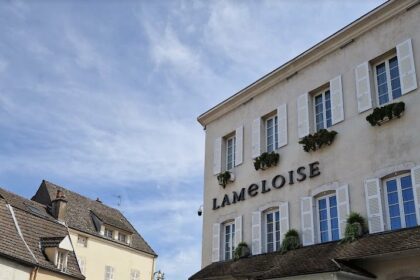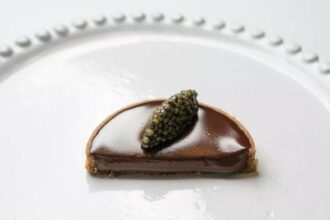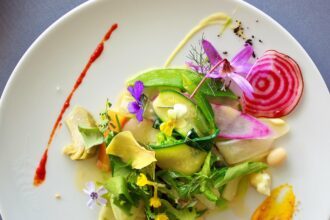The world looks like a bigger place when you stand on the edge of a hill. Light blue, dark blue and green… These are the colours that you can see on the horizon in Piedmont, Italy. It is clearly a landscape with an inspirational spectrum of colours for any artist. But, if you are into food, the colour that you should associate with Piedmont is actually white. That is because of tartufo bianco, which almost single-handedly places the region on the world gastronomy map. That being said, Piedmont offers far more than tartufo bianco, but I am admittedly unqualified to explain the cuisine by myself. Instead, I will leave this to two friends who have been visiting the region regularly and possess both practical and theoretical knowledge regarding the gastronomy and wine of Piedmont. Robert Brown is the co-owner of an art gallery in New York City. He actively contributed to the discussions on eGullet and has just launched his new blog, EngagingFood.com. Vedat Milor is probably the most famous food critic and TV personality in Turkey. You might also know him from Gastroville, the blog that he wrote with Hedone’s Michelin-starred chef Mikael Jonsson between 2004 and 2008. Vedat is now the lead editor of Gastromondiale.
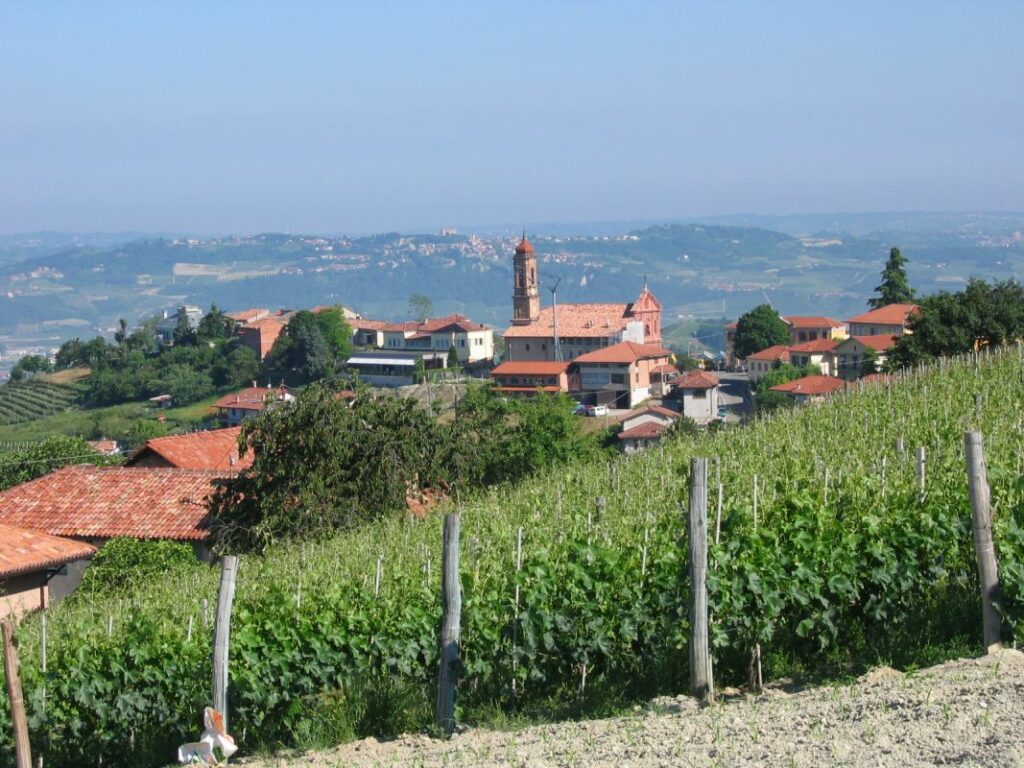
Besim Hatinoglu: (BH), Robert Brown: (RB), Vedat Milor: (VM)
BH: There are various criteria that critics use to assess dishes, restaurants and chefs. I have recently begun to think that ‘repetition’ could be one of those criteria. Of course, I am not referring to repetition in a negative sense, as in Sisyphus’s task. In gastronomy, repetition in the sense of returning to a restaurant, to a chef or a dish, signifies the most intense feelings. Here we have an opportunity to discuss repetition in a concrete context. Why do you make an annual pilgrimage to Piedmont? The answer seems obvious, but both tartufo bianco and the region’s grandi vini are available abundantly in culinary temples from Paris to San Francisco.
VM: Mikael Jonsson and I laid out our own criteria to assess dishes at Gastroville, now Gastromondiale, which we believe to be more comprehensive and focused than any criteria used by critics/guides. It is interesting that, from this vantage point, Piedmont is by no means at the top, or near the top of the ladder. I found higher quality pico magnatum at Da Vittorio near Bergamo, or, L’Ambroisie in Paris. All said, my wife and I paid visits to Alba starting in 1998 and, after a three-year hiatus, went again last November. Why? The main reason is the early and very positive impressions. It is in Piedmont that we discovered the true charm of tartufo bianco, which was widely available and at a reasonable price.
RB: Gastronomes are similar to culture vultures in that there are the microcosmic obsessives and the macrocosmic who “cover as much of the territory as possible”. I am clearly in the former group, the kind who sees “Citizen Kane” or “The Big Lebowski” 20 times, or, in my case, listens to certain albums 300 times over 40 years. I am like that when it comes to food, which is why my wife and I would fly from New York to France four times a year and each time would visit Alain Chapel for a few meals at a time until he left us way too early in 1990. So it is hard for me to understand why certain people, the lazy thinkers, chase around the world eating in as many top-rated Guide Michelin or San Pellegrino’s World’s 50 Best Restaurants List, usually just for one meal so they can say they have been there. We consider our annual truffle trip that we take soon after Thanksgiving as the highlight of our gastronomic year. Of course the reason for these trips are the truffles. Alba white truffles are simply miraculous especially when you pay a premium (though nothing like you have to pay in the States) to have them in a restaurant in Piedmont, which guarantees freshness and quality. It is a good time to go since truffles have a five-week growth cycle, so even if it is “a bad year for truffles”, the situation has pretty much straightened itself out toward the end of the season, although two years ago struck us as our most memorable truffle-eating ever. They are really flavor-enhancers particularly with raw veal, pasta made with butter, certain cow’s milk cheeses, raw eggs, and panna cotta ice cream. Yet, some chefs put them on cardoons and broccoli which I do not understand at all. Since we travel all that way from New York, we do not stint on wine. Unlike nearly every restaurant anywhere, Piedmont is the place to have mature, at-their-peak great wines if you like Barolos and Barbarescos.
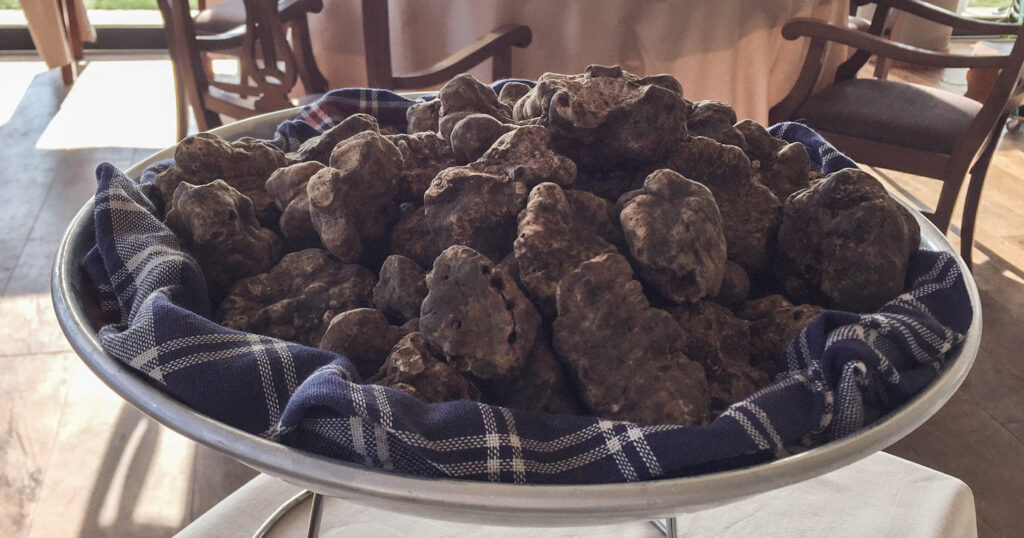
BH: If I understand correctly, you point to white truffles as the reason behind your trips and are referring to two fundamental factors that make Piedmont a special place for white truffles: quality/freshness of product and price. Let me understand these factors a bit more. You argue that quality tartufo bianco can enhance immensely the flavours of certain dishes and products. What would you say about the quality of those dishes or products in the region apart from tartufo bianco? Would this be something contributing to the quality factor?
RB: One factor is that selecting dishes for truffles puts you into a small corner in ordering, as the majority of Piedmont dishes do not work with them. Yet, I would never order one of these white truffle fixed menus or order a meal in which every dish is meant to go with truffles. Sometimes you can barely taste them, which is why we learned to limit them to certain dishes, but if you do not have a really good truffle, it is extremely frustrating. You will find most truffle dishes in the appetizing and pasta/risotto sections. I like to have a dish or two without truffles and then return to them with panna cotta or crema gelato. I used to go to Piedmont in the summer, but not for perhaps 15 years, after which my wife and I craved for fish and would visit the Tuscan coast and Venice and the Marche Coast instead. Seafood is all but ignored in Piedmont. So as an out-of-truffle-season cuisine, I prefer others in Italy. To me, a carne cruda without truffles is a slightly-better good steak tartare. So yes, Alba truffles are an almost-immense enhancement to certain classic Piedmont dishes.
BH: My intuition is that price may not be a major factor for the “macrocosmic gastronomes” since they are also globetrotting gastronomes dining in more expensive venues. Price is rather secondary to them. Should we add a third factor, say a sensual one, such as dining in a local setting which embraces certain elements as rusticity and authenticity?
RB: I am sure it is true that truffle prices are not a deterrent to what I call “Michelin star-chasers”. The first restaurant they would go to is Piazza Duomo in Alba which gets three stars. I have never been. To me it is a place that I might try in the spring or summer, but not for truffles. Other than that, I do not think those kind of traveling gastronomes are interested in rusticity or authenticity in the historical or classical sense of the word. Those kinds of restaurants usually get no stars. Okay, so Antica Corona Reale might make the cut since it gets two stars and has something of a Piemontese feel, but could also be someplace else. However, I sense that those “Michelin star-chasers” go to Piemonte to put notches in their belts whenever it suits their convenience regardless of the time of year, but I think a lot of foreigners you see there, particularly German-speaking, do wait for the truffle season to order good bottles.
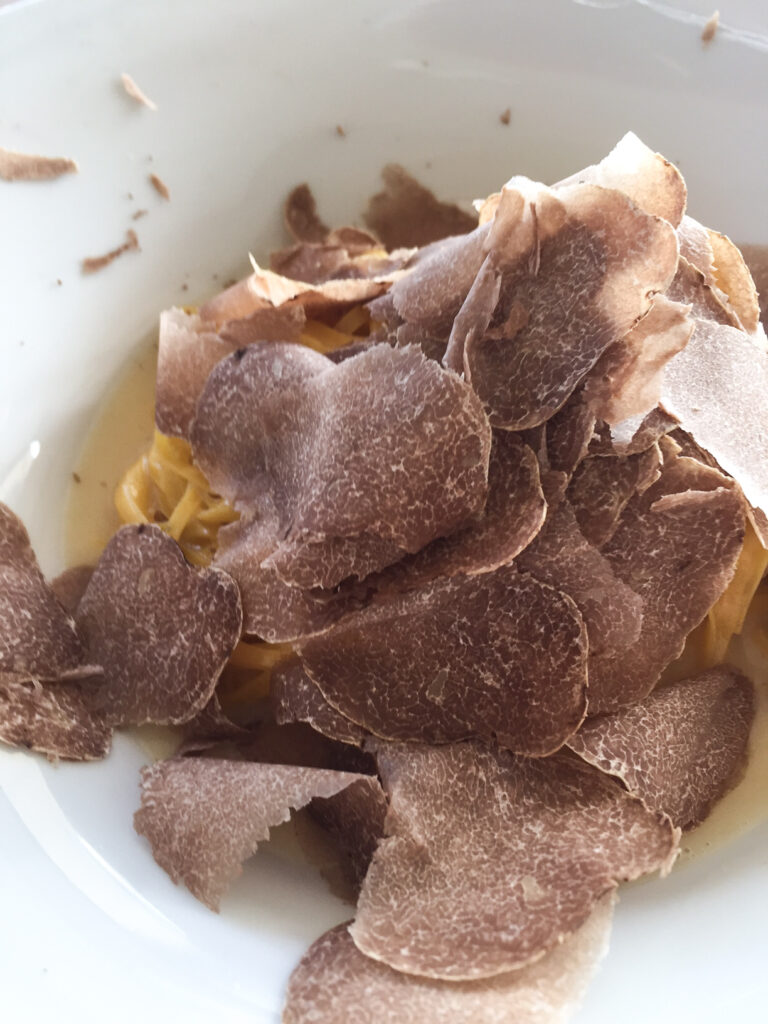
BH: When it comes to truffles, there are other premium products such as black truffles in France. However, people rarely visit those regions in France for the sole purpose of seeking out black truffles. So, the point is that Alba white truffle is one of the few, if not only, that makes well-heeled gastronome travel. I guess this contrast between white and black truffles could help us to complement the findings above.
RB: For sure people do not flock to the Rhone Valley for extended truffle-eating trips like they do in Piedmont. Black truffles are cheap compared to white ones for a reason; supply for one, intrinsic, comparative quality for another. They are not as flavorful or overwhelming as Alba truffles, but I would not want to denigrate them. They are great in scrambled eggs, and who would ever forget having a “poulet en demi-deuil” or “en vessie” which you can still get in Lyon at La Mere Brazier. Black truffles are more versatile, and you can have them in little pieces as well as sauces, but I just do not find them as magical as Alba truffles.
BH: Which dishes do you prefer to have with tartufo bianco? Any unusual dishes peculiar to the restaurants that you like visiting? More importantly, what are your favourite historical dishes with tartufo bianco?
VM: Gradually we came to the conclusion that, the simpler the preparation, the better. Best is with eggs (or eggs and raschera cheese a la Antica Corona Reale da Renzo), and second best is with tajarin. Two restaurants there fulfilled more than our expectations: Da Cesare and old Guido. When I think of the “porcini salad with peach”, “kid roasted in the fire place”, “hazelnut cookies” at Da Cesare and “agnolotti” at Guido, my ears still ring. I miss the disappearance of Cesare as much or more than the retirement of two Parisian chefs I loved: Robuchon and Senderens. Neither Cesare nor the real Guido now exist in Piedmont. But old habits die hard. Antica Corona Reale is now the only restaurant which is worth a detour, and one can eat well at Trattoria della Posta, Tornavento, and Da Bardon. It is actually very hard to find a bad restaurant in Piedmont, but there are no culinary heavyweights either (I dislike the 3 Michelin star Duomo in Alba).
RB: If you go to Pizza Duomo or Combal Zero outside of Torino, you will have “creative” dishes served with Alba truffles. To me, however, classic truffle dishes are historical, and those are what my wife and I always have, although sometimes you get a bit of interpretation. For us it is always the raw veal, a pasta such as tajarin or gnocchi, raw eggs mixed in with melted cheese, or risotto with cheese (usually Castelmagna). Chefs make beef or veal dishes with truffles, but I always found that the meat fought a bit with them, so we stopped trying it. We always eat in two restaurants, Ciau dei Tornavento and Antica Corona Reale da Renzo, the former because of the large array of truffle dishes and the biggest wine cellar in Italy (though apparently Enoteca Pinchiorri’s in Florence is more valuable because of their French holdings). Renzo to us usually has the best-tasting food. After these two restaurants, we vary the third. This year we returned to Il Centro after a long hiatus and it turned out to be our favorite of our trip because the cooking was a bit more personal and lighter.
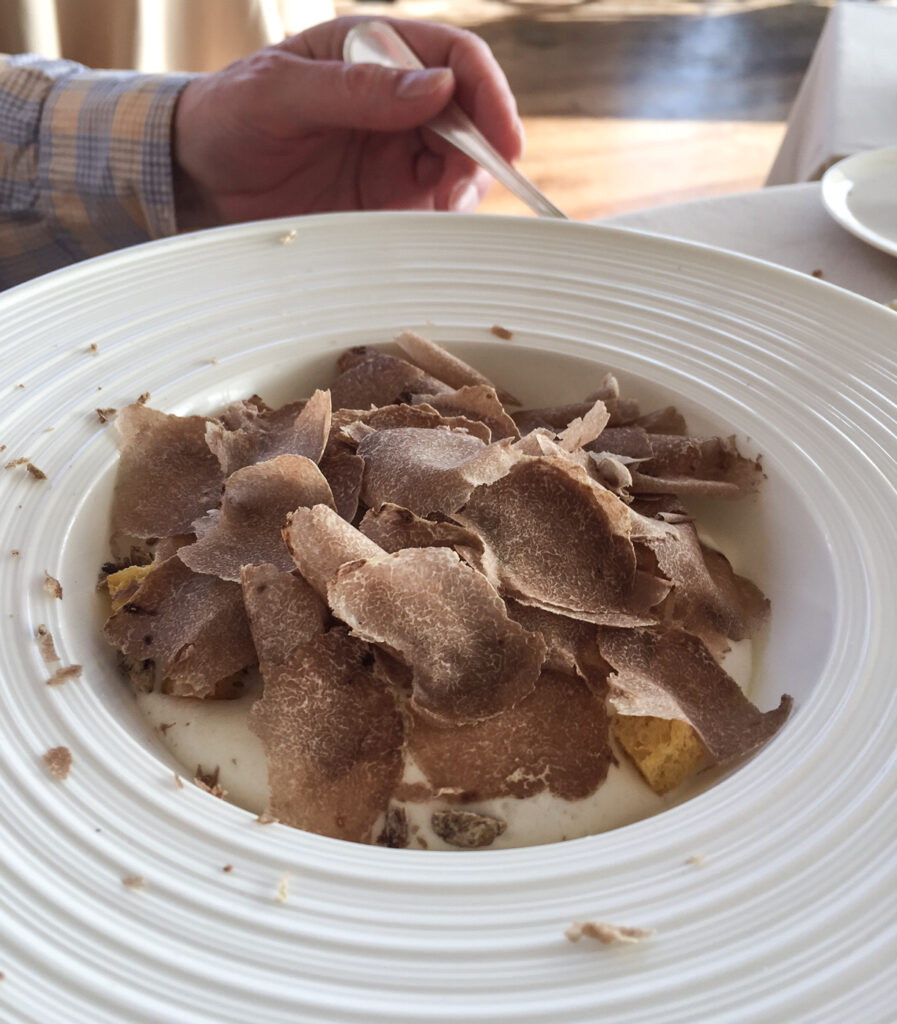
BH: Are you in a position to provide us with your opinion regarding the fundamentals of wine-pairing with truffle dishes? Perhaps, this would also a good opportunity to elaborate the primary-secondary relationship between white truffle and the dish that it accompanies.
VM: In my opinion grandi vini of the region, particularly young Barolo and Barbaresco, mask the subtle aroma and taste of tartufo bianco. I would suggest a white Chateauneuf, Saint Joseph or Hermitage or a white Bourgogne. But if you would like to drink a red wine of the region, I would recommend three strategies. First, I prefer to select a wine from the masters of old school such as G. Rinaldi, G.B. Burlotto, G. Conterno, B. Mascarello and a few others. Second, if you are choosing grandi vini, the older vintage it is, the better. Young Barolos are just too intense and tannic to pair with truffles. As these great wines age, they develop some woodsy and earthy secondary aromas that match with tartufi. The problem is that it is often hard to find old bottles in restaurants in Piedmont and it is even harder to find wines from representatives of the old school. Unfortunately, most of the wine in the region has been Parkerized when he gave 100 points to a Sandrone Barolo Cannubi 1990 aged in new barrique. The third strategy is to order a non Nebbiolo wine. A young Dolcetto works as it is less fruity than Nebbiolo and it has often an aroma reminiscent of roasted chestnuts. Other red wines of the region made from Freisa or Pelaverga grapes may also work as they are lower in alcohol than Nebbiolo. While I always find great French white wines that I mentioned, I have not tried them with truffle dishes yet. My hunch is that they will pair well with carne crudi with tartufi and plin stuffed with meat. These wines are also not expensive.
RB: I like to look to see what other people are doing in the dining room; how animated they are; if they are ordering a la carte or dégustation; or I try to see what wine they are drinking, for example. In Italian restaurants, particularly in Piedmont, it is very common to see a group of four to eight guys at a table drinking many bottles of wine. I believe that often they are in the wine trade. Piazza Duomo offers a choice of four wine pairings, but this is a very rare exception. A group of diners might consume several different bottles of wine, but these are whole bottles, maybe selected or brought to the restaurant before the convives knew exactly what they were going to eat. Wine pairings in the sense that you drink a glass with each course as selected by a sommelier is foreign to classic truffle meals. I never take wine pairings. In Piedmont especially, the cuisine is red-wine. The sommelier can direct you to a specific wine according to what he thinks would go best with your order, or what you want to pay. My wife and I always order a bottle from a great year and from a producer we like, sometimes one whose wines are hard to find back home. The bottle has a dynamic that you can follow according to what you are eating or how long it has been in the glass, opened bottle, or decanter. Maybe a sweet wine with dessert once in a while, but we are not fans of wine pairings, especially since all or most of the wines they make you drink are somewhat interesting at best and cheap fillers at worst.
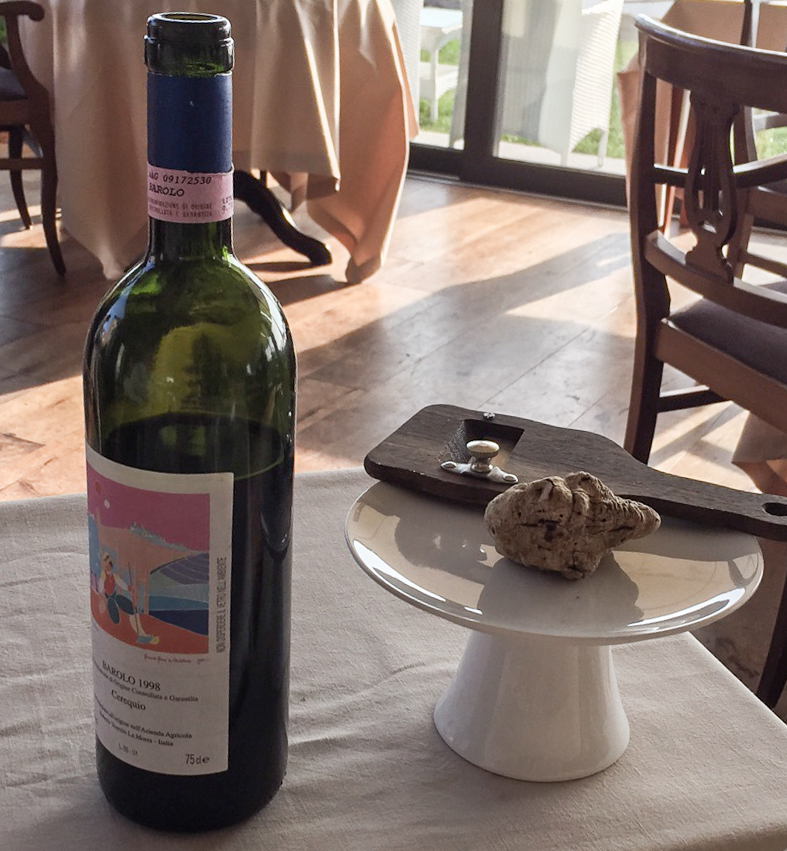
BH: At the beginning, we dwelled on the importance of ‘repetition’ for gastronomes. However, all worldly things are in a state of flux and this must be ‘repetition’ in that state of flux. While the act of going to Piedmont does not change in your case, what has changed or evolved (for better or worse) since your first visit to Piedmont?
RB: There are certainly a lot more restaurants, and a few we went to are no longer extant. This year we noticed a couple of budding trends that we find disconcerting. Restaurants in general are set up to cater both the budget diner and the extravagant one, but it seems rather suddenly that the gulf has widened. Top-level wines that a couple of years ago that could be had for 125-150 euros are now more like 175-250 euros. Truffles servings per dish that 20-25 euros are 30-35 euros. If you chose your own truffle, a 65-gram one might have been 125 euros recently, but now are close to 210. I noticed a big discrepancy between the market price and the restaurant price, which even last year, if I recall correctly, were just about the same. This year it was around 3.5 euros a gram when the market price was 2.2 euros a gram. Otherwise, in three of the restaurants we visited this past year, the overall quality was the same except for Ciau dei Tornavento, the reasons for which you can read on my “Engaging Food” site. To see them take the cheese chariot out of circulation when we were there at lunch is a bad sign.
BH: As you have been to the region so often and so regularly, I would consider you nearly locals. Or at least foreign gastronomes who had many chances to observe how locals enjoy tartufo bianco… Robert, for example, briefly touched upon the touristic trend that restaurants shave tartufo bianco on top of every single dish in a, say, 4-5 course menu. What do you think about this? Would locals enjoy their meal in this manner? Also, we discussed many things, but somehow neglected the topic of choosing the right tartufo bianco at the restaurants.
VM: Our strategy, after the early mistakes of “all truffle meals” has been to eat one, maximum two, truffle dishes during a meal. A related point is that, in the region, for the most part, you can choose your own truffle and it is weighed before your eyes.
RB: It is interesting that I noticed that almost no one chooses their own truffle. Actually I learned you could do this from dining with Vedat several years ago. I like the ritual of touching and sniffing several truffles and then having it weighed before and after to see how much of it you consumed. I think a problem is that the first one you sniff often seems to be the best, so you have to keep going back and forth. This time Ciau dei Tornavento brought out a dish with 50 or so truffles, so obviously I could not smell all of them. After I narrow things down to a few, I will ask the more-experienced waiter to tell me the one he likes the best. How much better this ceremony is compared to someone bringing a truffle to you from the kitchen is, of course, unknowable. Truffles weighing over 50 grams are a bit more expensive than those less than 50 grams. That should tell you that to a certain extent, bigger should be better. As I said above, we don’t order every dish with truffles. I do not think locals do either especially given that they can have truffle dishes many times over a season. I suspect they have one or two such dishes every restaurant visit. In 2015 we went to Belbo da Bardon (and Vedat went this past trip), which caters almost entirely to locals, it seemed that everyone except us was availing themselves of the bollito misto wagon.
BH: Before we conclude this discussion, I would like to address my last questions. Vedat, it is clear that you like Piedmont. Otherwise, why would you keep going back so often? However, I can also see that you are not so enthusiastic about it.
VM: Yes, you are right to some extent. Alba for me now is like a reliable old friend who makes me happy knowing that he exists, but I am not too eager either to make special arrangements to visit too frequently. That being said, following many years of overly refined cooking in Michelin type restaurants, I appreciate that Alba offers more rustic and substantial fare.
BH: Robert, you were definitely the more enthusiastic one about Piedmont. In your remarks, you often touched upon the smelling and tasting notes of tartufo bianco. What would your short answer be if I asked you to describe what it tasted like?
RB: I get flummoxed trying to describe their taste and smell. They are pungent for sure, but what can you compare them to? They grow in the ground, same as mushrooms, but are stronger. People have use the dirty socks or B.O. comparison, but that is demeaning. They are not like onions or other tubers like potatoes. You would not want to eat one by itself, although I took the last remaining shard of one and chewed on it. I was surprised how good it tasted and how mellow it was.
BH: I would like to thank you both for your comments. After listening to you and learning a lot from your comments, it should be easy to encapsulate the whole conversation in a few words. But it is not. And it is not because Piedmont is not any random gastronomic destination. Gastronomy reaches culmination in that breathtakingly beautiful setting. Some says repetition is the death of art. But, I would say, it has the most special meaning in the context of gastronomy.
Special thanks to Gokhan ATILGAN of Mizanplas for his valuable comments.
